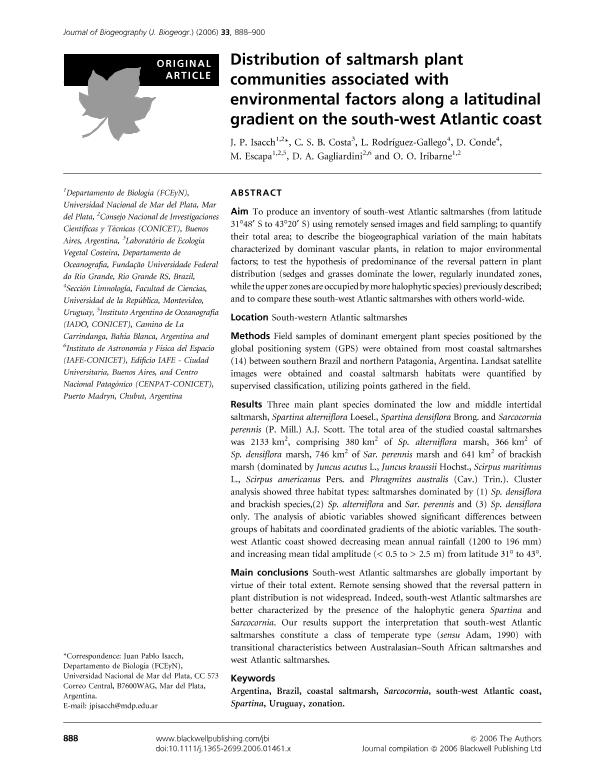Mostrar el registro sencillo del ítem
dc.contributor.author
Isacch, Juan Pablo

dc.contributor.author
Costa, C. S. B.
dc.contributor.author
Rodríguez Gallego, L.
dc.contributor.author
Conde, D.
dc.contributor.author
Escapa, Mauricio

dc.contributor.author
Gagliardini, Domingo Antonio

dc.contributor.author
Iribarne, Oscar Osvaldo

dc.date.available
2017-12-04T17:07:10Z
dc.date.issued
2006-12
dc.identifier.citation
Isacch, Juan Pablo; Costa, C. S. B.; Rodríguez Gallego, L.; Conde, D.; Escapa, Mauricio; et al.; Distribution of saltmarsh plant communities associated with environmental factors along a latitudinal gradient on the south-west Atlantic coast; Wiley Blackwell Publishing, Inc; Journal of Biogeography; 33; 5; 12-2006; 888-900
dc.identifier.issn
0305-0270
dc.identifier.uri
http://hdl.handle.net/11336/29563
dc.description.abstract
Aim To produce an inventory of south-west Atlantic saltmarshes (from latitude 31 48 ¢ Sto43 20 ¢ S) using remotely sensed images and field sampling; to quantify their total area; to describe the biogeographical variation of the main habitats characterized by dominant vascular plants, in relation to major environmental factors; to test the hypothesis of predominance of the reversal pattern in plant distribution (sedges and grasses dominate the lower, regularly inundated zones, whiletheupper zones are occupiedby more halophytic species)previously described; and to compare these south-west Atlantic saltmarshes with others world-wide. Location South-western Atlantic saltmarshes Methods Field samples of dominant emergent plant species positioned by the global positioning system (GPS) were obtained from most coastal saltmarshes (14) between southern Brazil and northern Patagonia, Argentina. Landsat satellite images were obtained and coastal saltmarsh habitats were quantified by supervised classification, utilizing points gathered in the field. Results Three main plant species dominated the low and middle intertidal saltmarsh, Spartina alterniflora Loesel., Spartina densiflora Brong. and Sarcocornia perennis (P. Mill.) A.J. Scott. The total area of the studied coastal saltmarshes was 2133 km 2 , comprising 380 km 2 of Sp. alterniflora marsh, 366 km 2 of Sp. densiflora marsh, 746 km 2 of Sar. perennis marsh and 641 km 2 of brackish marsh (dominated by Juncus acutus L., Juncus kraussii Hochst., Scirpus maritimus L., Scirpus americanus Pers. and Phragmites australis (Cav.) Trin.). Cluster analysis showed three habitat types: saltmarshes dominated by (1) Sp. densiflora and brackish species,(2) Sp. alterniflora and Sar. perennis and (3) Sp. densiflora only. The analysis of abiotic variables showed significant differences between groups of habitats and coordinated gradients of the abiotic variables. The south- west Atlantic coast showed decreasing mean annual rainfall (1200 to 196 mm) and increasing mean tidal amplitude (< 0.5 to > 2.5 m) from latitude 31 to 43 . Main conclusions South-west Atlantic saltmarshes are globally important by virtue of their total extent. Remote sensing showed that the reversal pattern in plant distribution is not widespread. Indeed, south-west Atlantic saltmarshes are better characterized by the presence of the halophytic genera Spartina and Sarcocornia . Our results support the interpretation that south-west Atlantic saltmarshes constitute a class of temperate type ( sensu Adam, 1990) with transitional characteristics between Australasian–South African saltmarshes and west Atlantic saltmarshes.
dc.format
application/pdf
dc.language.iso
eng
dc.publisher
Wiley Blackwell Publishing, Inc

dc.rights
info:eu-repo/semantics/openAccess
dc.rights.uri
https://creativecommons.org/licenses/by-nc-sa/2.5/ar/
dc.subject
Argentina
dc.subject
Brazil
dc.subject
Coastal Saltmarsh
dc.subject
Sarcocornia
dc.subject
South-West Atlantic Coast
dc.subject
Spartina
dc.subject
Uruguay
dc.subject
Zonation
dc.subject.classification
Otras Ciencias Biológicas

dc.subject.classification
Ciencias Biológicas

dc.subject.classification
CIENCIAS NATURALES Y EXACTAS

dc.title
Distribution of saltmarsh plant communities associated with environmental factors along a latitudinal gradient on the south-west Atlantic coast
dc.type
info:eu-repo/semantics/article
dc.type
info:ar-repo/semantics/artículo
dc.type
info:eu-repo/semantics/publishedVersion
dc.date.updated
2017-11-21T13:56:43Z
dc.journal.volume
33
dc.journal.number
5
dc.journal.pagination
888-900
dc.journal.pais
Reino Unido

dc.journal.ciudad
Londres
dc.description.fil
Fil: Isacch, Juan Pablo. Consejo Nacional de Investigaciones Científicas y Técnicas; Argentina. Universidad Nacional de Mar del Plata; Argentina
dc.description.fil
Fil: Costa, C. S. B.. Fundacäo Universidade Federal do Rio Grande; Brasil
dc.description.fil
Fil: Rodríguez Gallego, L.. Universidad de la República; Uruguay
dc.description.fil
Fil: Conde, D.. Universidad de la República; Uruguay
dc.description.fil
Fil: Escapa, Mauricio. Consejo Nacional de Investigaciones Científicas y Técnicas. Centro Científico Tecnológico Conicet - Bahía Blanca. Instituto Argentino de Oceanografía. Universidad Nacional del Sur. Instituto Argentino de Oceanografía; Argentina. Universidad Nacional del Sur; Argentina
dc.description.fil
Fil: Gagliardini, Domingo Antonio. Consejo Nacional de Investigaciónes Científicas y Técnicas. Oficina de Coordinación Administrativa Ciudad Universitaria. Instituto de Astronomía y Física del Espacio. - Universidad de Buenos Aires. Facultad de Ciencias Exactas y Naturales. Instituto de Astronomía y Física del Espacio; Argentina. Consejo Nacional de Investigaciones Científicas y Técnicas. Centro Científico Tecnológico Conicet - Centro Nacional Patagónico; Argentina
dc.description.fil
Fil: Iribarne, Oscar Osvaldo. Instituto Nacional de Invest.y Desarr.pesquero. Proyecto Especies Costeras; Argentina
dc.journal.title
Journal of Biogeography

dc.relation.alternativeid
info:eu-repo/semantics/altIdentifier/doi/http://dx.doi.org/10.1111/j.1365-2699.2006.01461.x
dc.relation.alternativeid
info:eu-repo/semantics/altIdentifier/url/http://onlinelibrary.wiley.com/doi/10.1111/j.1365-2699.2006.01461.x/abstract
Archivos asociados
